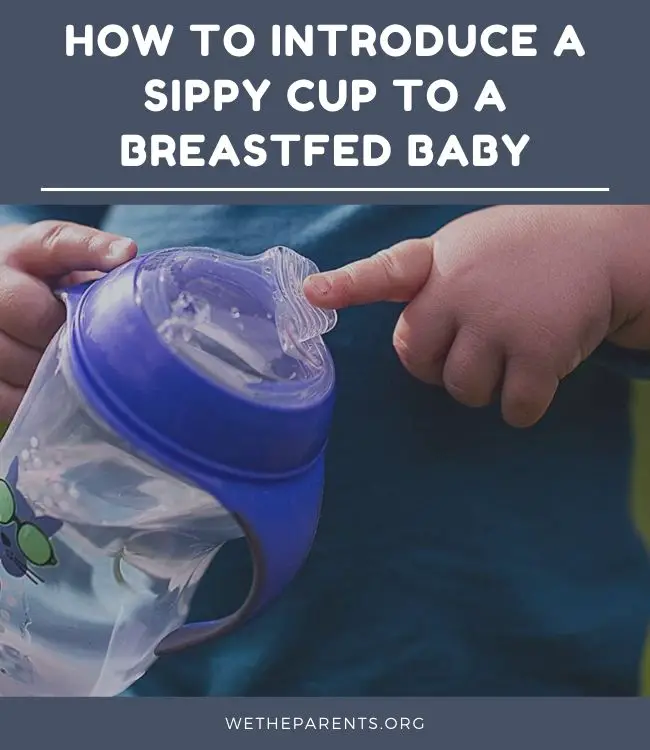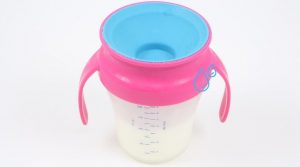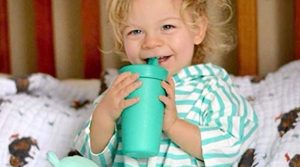When you’re a nursing mom, being able to pump milk when your body is ready and nourish baby through bottle-feeding later is a godsend.
Of course, even if you’re still actively nursing, time will roll around for your baby to transition from bottles to sippy cups for the sake of their oral health and development.
If the baby is overly attached to its bottle, or almost always nurses directly, accepting and learning to use a sippy cup could take some extra effort. We’re here to help you get the job done while minimizing the struggle, so read on!
In this article:
Why is it important to transition away from bottles?
While drinking from a bottle is a great way for babies to feed during early infancy, by the time they’re hitting the one-year mark, it’s time to make the transition to a sippy cup.
Here are some reasons for this.
- Drinking from a bottle can increase tooth decay, as the action of drinking liquid from a bottle places sugar onto the teeth, rather than inside the mouth. This means that it will linger on the teeth (while creating cavities) for longer than if they were using a sippy cup.
- When babies or toddlers drink too long from a bottle, they risk developing weight issues as soon as early childhood. Research says that when toddlers are still bottle-feeding at two years old, their likelihood of being obese by age six increases.1Science Daily This is likely because they’ve learned to tote their bottle around with them, drinking when bored or agitated, rather than when hungry, leading to excess calorie intake. At this age, children should be eating solid food. On the other hand, some children refuse solids in favor of their bottle, depriving them of important nutrients found in healthy solids.
- Drinking from a bottle beyond the appropriate developmental age can have a negative impact on your child’s future adult teeth. Continuously sucking on a bottle can impact the way the roof of your child’s mouth and facial muscles develop, which can make teeth crooked, lead to an overbite, or require orthodontic intervention.
When should a breastfed baby start using a sippy cup?
By the time your baby reaches 12 months, they should be drinking from a sippy cup exclusively. Though direct nursing is still encouraged, many mothers will find their babies naturally nursing less, leading to a diminishing milk supply.
In order to ease this transition, it’s recommended that parents introduce a sippy cup as soon as babies are old enough to use one.
Per the American Academy of Pediatrics, 6 months is about the earliest you should consider introducing a sippy cup.
At 6 months, babies are typically able to sit up by themselves in a high chair, a good indicator that their neck is strong and they can move their limbs effectively.
Though you may wish to introduce a sippy cup at this point, the AAP notes that 9 months is actually a better age for making the bottle-to-cup transition.
This is because, while baby may be physically able to drink from a sippy cup, they may not be ready to relinquish the significant emotional attachment associated with ongoing bottle use.
What are the best sippy cups for a breastfed baby?
One reason why breastfeeding babies are notoriously stubborn about sippy cups is the difference in sensation.
Sippy cups, which use a hard, plastic spout for drinking, don’t feel the same as nursing, or like the rubber or silicone nipples baby is used to.
Cups which use large, soft tops and silicone spouts feel more natural, and are best for the transition. Pick up an assortment of these (there are many options), as each baby seems to develop their own preference.
Parents should note that the American Dental Association recommends that parents avoid the use of sippy cups with no-spill valves as these encourage babies to suck on, rather than drink from, the cup’s spout.
How can I get my breastfed baby to drink from a sippy cup?
Transitioning from bottles to cups can sometimes be tougher for babies who are used to nursing. Taking things slowly, being deliberate, and staying positive, are the keys to making a successful changeover.
- Choose the right type of cup, and have a few versions available: As noted above, a cup with a silicone spout is the best sippy cup when transitioning a nursing baby from bottle to cup. This is because the softer spout feels more like the bottles and nursing that they’re accustomed to. Having a few different options on hand can discourage frustration, as babies can be picky about which cup becomes ‘the’ cup they decide to drink from. Cups with handles are also helpful, as babies may struggle to hold a cup with both hands without them.
- Help them understand the cup: Without an indication of what’s inside, using a sippy cup can be confusing for babies. Putting a little breast milk, or juice, on the spout while letting them examine, smell, and taste it can help them make the connection. Keep offering the cup to them, gently demonstrating how it works, being patient as they get used to it.
- Let them examine the cup: Sippy cups are deliberately designed to avoid messes, so letting them examine, play with, and hold them is fine — it’ll help them get better acquainted with it. Practicing with it in the bathtub means that, even if an accidental leak or spill happens, there’s nothing to clean up.
- Keep calm and patient: When parents become stressed with major milestone transitions, kids will usually sense it and respond in kind — yes, even babies! By staying patient, calm, positive, and consistent, you demonstrate healthy and loving behavior, helping them feel comfortable as they acclimate to their new experience. Positive encouragement is huge here, as your child will happily respond to enthusiasm, wide smiles, and heaps of praise. Even if they don’t understand why they’re doing something right, they’ll wish to repeat such behavior in the future.
Sippy cup safety
We’d be remiss not to mention that, with the arrival of sippy cups, come new safety rules that parents and children should follow. Make sure to give these guidelines a look before presenting your child with their new cup.
Clean it thoroughly, every time
Sippy cups, especially those with small parts like a straw cup, have tiny crevices and threads where mold and mildew can quickly appear. Always clean sippy cups thoroughly after each use, including the insides of spouts and straws, to avoid contaminating breast milk (or any other beverage) your child is drinking. If a cup cracks, displays permanent discoloration, or the silicone top is showing wear, dispose of it immediately.
No walking around with the cup
Not only is it unhealthy for tots to be constantly drinking from their sippy cup, but an accidental fall while drinking on the run can seriously hurt their little face — think broken noses and teeth. Drinking while stationary is best!
Opt for a silicone top or straw cup
A hard, plastic spout on a sippy cup isn’t great, as it places the liquid your child drinks in front of their teeth rather than behind them, increasing the likelihood of tooth decay.
The bottom line
Changing from bottles to sippy cups can be a challenge, but preparing yourself with the best sippy cups — think silicone spouts and handles — can help ease the switch.
Remember to keep things simple, considering your baby’s sense of attachment to their bottle. Let them feel comfortable, confident, and supported as you introduce them to their new sippy cup.
And practice makes perfect — you’ll cheer with relief when they ask for their cup instead of their old bottle!




